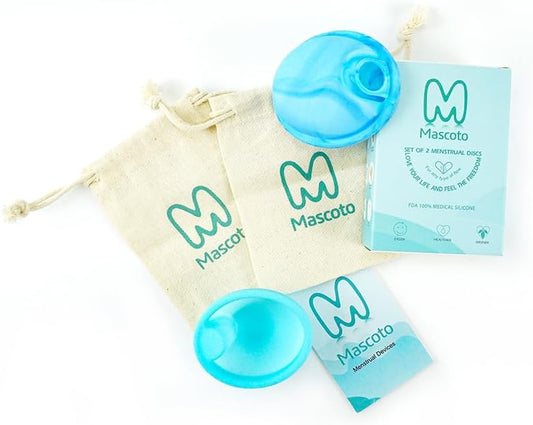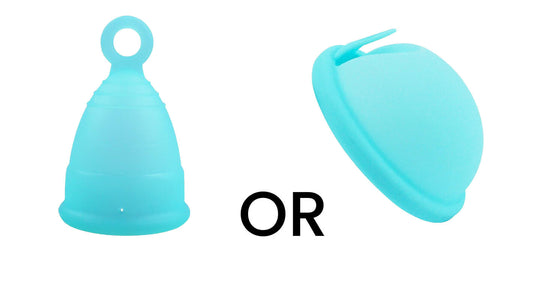Menstrual Disc Leaking: How to Prevent Leaks with Confidence
Share
- Menstrual Disc Leaking: Common Challenges and Concerns
- Step-by-Step Guide to Inserting a Menstrual Disc
- Importance of Size and Fit in Leakage Prevention
- Frequently Asked Questions about Menstrual Disc Leakage

In the realm of menstrual hygiene, menstrual discs have emerged as an innovative and discreet alternative to traditional period products. A menstrual disc is a small, flexible device designed to collect menstrual fluid internally, positioned at the cervix within the vaginal canal.
Difference from menstrual cups:
- Unlike conventional methods such as pads or tampons, which absorb menstrual blood, a disc captures and holds the fluid in a cup-like compartment. This design not only provides reliable leak protection but also offers a sustainable and comfortable option for individuals seeking a more liberating period experience.
- What sets menstrual discs apart from their traditional counterparts is their unique placement and function. Unlike tampons, which are inserted into the vaginal canal and positioned lower, menstrual discs are situated higher up, near the cervix. This strategic placement allows for a more natural and less intrusive fit, reducing the likelihood of discomfort and leakage. Moreover, while pads and tampons need frequent changes, menstrual discs can typically be worn for longer durations, depending on individual flow. This extended wear time, combined with the collection mechanism, makes menstrual discs an appealing choice for individuals aiming to minimise disruptions in their daily routines and achieve a higher level of discretion.
- Additionally, this is the only menstrual device that can be used during sexual intercourse. Positioned on the cervix, the disc keeps the vaginal area clean and 'free,' allowing for sexual activity during menstruation.
- The disc has no suction effect that menstrual cups possess. Therefore, it offers a solution for women who experience discomfort due to suction, or those concerned about the potential impact on their sensitive vaginal area.
- Furthermore, the environmental impact of menstrual discs cannot be overlooked. Traditional products contribute significantly to waste production, whereas menstrual discs, typically made from medical-grade silicone or elastomer, are reusable and eco-friendly. With their potential to lessen the environmental burden and revolutionise period care, menstrual discs provide a modern solution that aligns with the values of both convenience and sustainability. As the discourse around menstrual health continues to evolve, the versatility and unique design of menstrual discs have positioned them as a noteworthy contender in the quest for leak-free and comfortable period management.
Menstrual Disc Leaking: Common Challenges and Concerns
One of the primary challenges associated with menstrual discs is the potential for leakage. While these innovative devices are designed to offer reliable leak protection, instances of leakage can still occur, leading to inconvenience and discomfort. Leaks can be disheartening, as they might compromise an individual's confidence and disrupt their daily routine. Understanding the factors that contribute to leakage and learning effective strategies to address this issue can significantly enhance the overall experience of using menstrual discs.
Factors Contributing to Leakage
Several factors can contribute to leakage when using menstrual discs. Incorrect insertion is a common culprit – if the disc isn't positioned correctly or is not fully opened upon insertion, it might not create the necessary seal to prevent leaks. Additionally, selecting the wrong size or type of disc for one's anatomy can also increase the risk of leakage. Factors such as a heavy flow or sudden movements can disrupt the positioning of the disc, causing leaks. It's important to recognize that leakage isn't solely a result of user error; individual anatomy and menstrual flow patterns can also play a role.
Impact on Daily Activities and Confidence
Experiencing leakage from a menstrual disc can have a notable impact on an individual's daily activities and self-assurance. Leaks can lead to staining of clothing, making individuals feel self-conscious and anxious about potential visible evidence of their period. The uncertainty of leakage can also limit one's freedom to engage in physical activities as the fear of accidents looms. This concern can be particularly pronounced during social situations, workouts, or even while sleeping. The potential for leaks can undermine the empowerment and convenience that menstrual discs are meant to provide.
As we delve deeper into the realm of menstrual disc usage, it's crucial to address these common challenges head-on. By understanding the factors that contribute to leakage and learning how to mitigate these risks, individuals can make informed choices and embrace the benefits that menstrual discs offer.
Step-by-Step Guide to Inserting a Menstrual Disc
Inserting a menstrual disc for the first time might seem daunting, but with a bit of practice, it becomes a straightforward process. Here's a step-by-step guide to help you navigate the insertion with ease:
- Wash our hands: begin by thoroughly washing your hands with soap and water. Clean hands are essential to ensure the hygiene of the process.
- Find a comfortable position: choose a comfortable position to insert the disc. Many find that squatting, sitting on the toilet, or raising one leg can make insertion easier.
- Fold the menstrual disc: gently in half, forming a shape that resembles a 'W,' in general it will looks similar to a tampon. This will make it easier to insert (see image below).
- Insert the disc: with one hand, hold open your labia to create a clear path to your vaginal opening. With the other hand, insert the folded disc into your vagina, aiming it towards the small of your back.
- Push the disc past the pubic bone: continue pushing the disc back and upwards. You might feel resistance as the disc moves past your pubic bone. Keep pushing until the disc is comfortably positioned higher up in your vaginal canal.
- Check and adjust: once the disc is inserted, use your finger to check if it has fully opened and is positioned just below your cervix. Run your finger around the edge of the disc to ensure it's fully unfolded and creating a seal.
- Test the seal: to check the seal, give the disc a gentle tug. If you feel resistance, it means the disc is correctly positioned and sealed against the cervix.
- Comfort and placement: you shouldn't feel the disc if it's correctly inserted. If you do, it might need some adjustment. You can gently push it further up or pull it slightly down if necessary.
- Wash your hands again: after successfully inserting the disc, wash your hands once more to maintain hygiene.
Importance of Size and Fit in Leakage Prevention
Choosing the correct size and fit of a menstrual disc is paramount when it comes to preventing leakage. Just as with any clothing or accessory, a proper fit ensures optimal performance. A disc that's too small may not create an effective seal, leading to potential leaks, while one that's too large might cause discomfort or difficulty in insertion. Achieving the right size and fit is a key step towards a leak-free experience and maximum comfort during your period.
How to Choose the Right Size and Type
Selecting the right size and type of menstrual disc involves understanding your individual anatomy, flow, and personal preferences. Here's how to make an informed decision:
- Know your flow: understanding your menstrual flow is crucial. If you have a heavy flow, you might want to opt for a larger capacity disc. Lighter flows might require a smaller size.
- Measure your cervix height: the position of your cervix can determine the ideal size for you. If your cervix is higher, you might require a larger disc to ensure proper coverage.
- Consider previous leakage: if you've experienced leaks with a certain size or brand in the past, it could indicate a need for a different size or type of disc.
- Explore brands and designs: different brands offer varying sizes and designs. Some discs are designed for easy insertion, while others prioritize capacity. Read product descriptions and reviews to find what aligns with your needs.
- Start with a smaller size: if you're new to menstrual discs, consider starting with a smaller size. They can be easier to insert and are less likely to cause discomfort.
- Consult customer support: many manufacturers provide customer support to help you choose the right size. Don't hesitate to reach out if you're unsure.
- Be open to adjustments: remember that finding the perfect fit might require a bit of trial and error. Be patient and open to trying different sizes and brands.
Incorporating these steps into your decision-making process can significantly enhance your comfort and confidence while using a menstrual disc. By choosing the right size and fit, you're setting the stage for a leak-free period experience that aligns with your unique needs and preferences.
Frequently Asked Questions about Menstrual Disc Leakage
Q: Why does leakage occur with menstrual discs, even when properly inserted?
A: Leakage can occur due to various factors, including an improper seal, disc positioning, or a heavy flow that exceeds the disc's capacity. It's important to ensure the disc is fully opened and positioned correctly near the cervix for a secure fit.
Q: Can I prevent leaks during physical activities such as workouts or swimming?
A: Yes, you can. Using a well-fitted menstrual disc and checking the seal before engaging in physical activities can help prevent leaks. Additionally, some individuals find wearing period-proof underwear or a liner as backup can offer extra peace of mind.
Q: Is it normal to experience leaks overnight when using a menstrual disc?
A: While menstrual discs are designed to offer extended wear, leaks can still occur due to movement during sleep or a particularly heavy flow. Experimenting with different disc placements and emptying the disc before sleep might help minimize leaks.
Q: Can leakage be caused by choosing the wrong size or type of menstrual disc?
A: Absolutely. Choosing the wrong size or type can impact the effectiveness of the disc. If the disc is too small, it may not create a proper seal, and if it's too large, it might be uncomfortable or challenging to insert. Selecting the right size and type based on your anatomy and flow is essential.
Q: What should I do if I experience leaks while using a menstrual disc?
A: First, don't be discouraged. Leaks can be managed with some adjustments. Try repositioning the disc, ensuring a proper seal, and experimenting with different folding techniques during insertion. If leaks persist, consider consulting the manufacturer's customer support for guidance.



